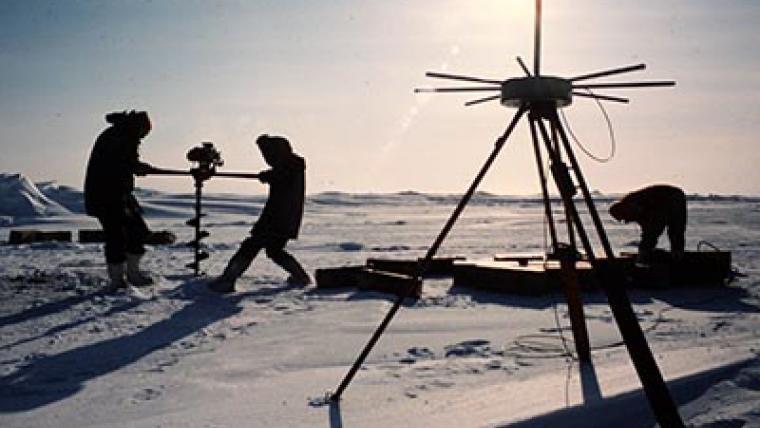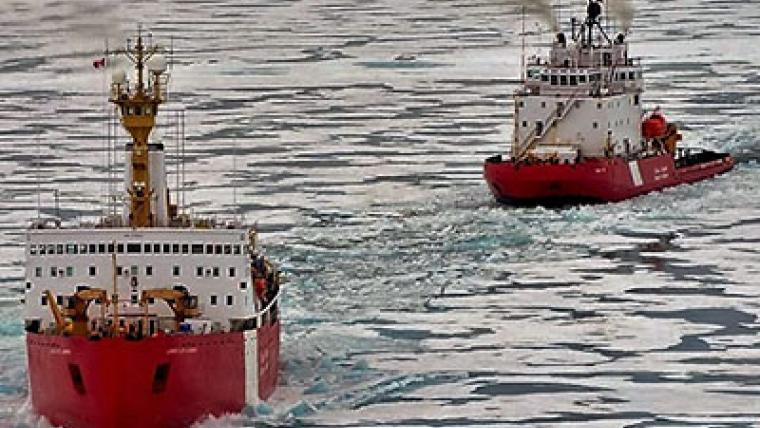Climate change: Arctic coastlines eroding up to 40 m yearly
By Joe McKendy
February 28, 2018
Talk of climate change impact often focuses on the future — 10, 20 or 50 years ahead. But in the Arctic, the erosion of coastline can sometimes be measured from one day to another.
“When you go to Canadian Arctic, in particular the Beaufort Sea, we see changes in a summer, in a month, sometimes even in a day, during coastal storms” says Dustin Whalen of Natural Resources Canada. He estimates that 30 to 40 m of coastline can be lost to the sea each year.
Larger image
The team
Imagine waterfront where you live, receding each year by as much as three school buses, lined up end to end.
Whalen and his team are looking at the rate of coastal erosion on an uninhabited island in the Beaufort Sea, near Tukoyaktuk, NWT. Pelly Island is losing its coastline at a rate 20 to 30 times faster than anywhere else in Canada. “The island could disappear completely in the next 50 years,” he says.
Two main factors influence coastal erosion in this region: warming air temperatures and coastal waves. Increasing temperatures thaw coastal permafrost, and large sections of the coastline fall into the sea. The decrease in sea ice creates longer seasons of open water, leading to more waves and storm surges hammering the coastline. These can undercut the frozen coast, causing blocks as large as a house to break off into the sea.
Submerged cameras give way to drones
Larger image
Pelly Island
When they first started working on Pelly Island, the team placed time-lapse cameras on land to capture the changes in coastline. But the rate of erosion is so fast that land beneath the cameras gave way, and the equipment wound up in the sea.
Now, the team mounts cameras on drones. They us the images and other data to build 3D models and compare the changes from year to year.
“What we’re really trying to study is what the effect this dramatic accelerated erosion has on near shore ecosystems, landscapes and communities,” says Whalen.
When sediment winds up in the sea
One thing is certain: Erosion is changing the seabed. Sediment eroded from the cliffs is deposited on the seabed and transported in the water column. What was once sandy bottom might now be covered with mud, or vice versa. Thawing frozen sediments from the cliff can also contain excess nutrients like carbon, which may dramatically change the chemistry of the water.
These changes could be affecting every living thing in the water, including the Beluga whale. Some of Dustin’s research is focused in the Tarium Niryutait Marine Protected Area, where more sediment could be a problem for the Beluga habitat or for its prey.
The science of an empty plate
Larger image
Pullen Island
Changes related to erosion may have been affecting the food supply for 10-15 years in nearby Tuktoyuktuk, where the Inuit are asking Department of Fisheries and Oceans (DFO) officials what they think about the disappearance of herring. New sediment may be covering areas where the herring once spawned.
Researchers are very interested in such first-hand, traditional observations. “It’s also neat in that it confirms that the Inuit are realizing the importance of the science being done in the area,” says Dustin. It’s too soon to suggest a definite link between erosion and the missing herring, but it’s well worth exploring.
Changing channels
When a river meets a lake or the sea, the water slows down and loses the power to carry sediment. The layers of sediment that build constitute a delta. The area Dustin studies is part of the McKenzie Delta, second only to the Mississipi Delta as the largest in North America. This accounts for waters in the Mackenzie estuary being no deeper than three to four metres, stretching several kilometres from shore.
Larger image
Toker Point
The sediment added by coastal erosion makes those waters even more shallow, which could threaten all-important shipping channels. Tuktoyuktuk is the only Canadian port on the Beaufort Sea, where barges refuel when delivering essential supplies to remote Arctic communities. If Arctic oil and gas, tourism and other economic activity increases, the shipping channels will be increasingly important.
“Questions about where sediment goes and how it affects ecosystems are very important,” says Dustin. Natural Resources Canada is working with DFO to discover how climate-driven coastal changes can affect the nearshore eco-system and biodiversity.
Page details
- Date modified:

